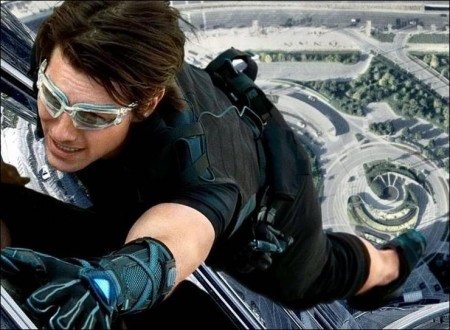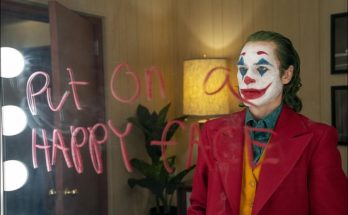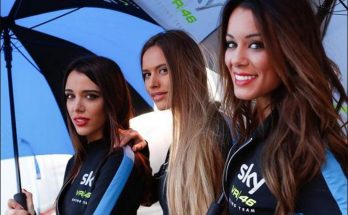Ghost Protocol: The Burj Khalifa Shootings. Located in the United Arab Emirates, Dubai is visually striking. “It’s cinematic from the get-go,” notes Bird. “A lot of the architecture is very imaginative and seems so futuristic. The fact that it’s surrounded by desert is such a surreal sight because it’s just dunes and flatness, and then there’s this city rising up like Oz.” The city had never truly been photographed for a motion picture portraying itself before. Filmmakers had not yet taken advantage of the vertical scale of the Dubai until GHOST PROTOCOL.
The producers had suggested using the Burj Khalifa for something to the writers, Josh Appelbaum and André Nemec. “It’s one of the first things you look at,” says Bird. “It’s this gleaming, really quite beautiful building that sticks up like a needle touching space.” The Burj had also been on Cruise’s radar who had seen the structure under construction. “I’m always looking at different structures, thinking, ‘How can I climb that? How can I jump out of that?’” he says.
Recalls Nemec, “We were talking about the building sequence and we thought, ‘What’s the scariest, most bad-ass thing we could imagine?’ Well, the answer was, ‘Let’s make him climb the outside of that building, in the interest of keeping the mission alive.’ loved the idea.” In the film, Ethan must climb the exterior of the Burj – the tallest building in the world, topping out at 2,716.5 feet (828 meters) to reach an upper floor security control area without being detected.
The building, which has three uses – a hotel, corporate suites and condominium residences – was scouted several times by stunt coordinator Gregg Smrz and his team who bravely examined the structure’s exterior themselves to figure out how to safely get Cruise out on the outside of the building for the various stunts called for in the script.
The production team began planning the obvious way to implement the scene: build a set on a soundstage representing a piece of the building, and have Cruise climb that, under controlled conditions. “We were going to build this set, have Ethan climb it, and then digitally extend all the shots to show the rest of the building,” explains Visual Effects Producer C. Peitzman. “We sat around in meetings, went through previz and storyboards and spent lots of time designing all these shots. Then we sat down with and, of course, he wanted to climb the real building. That put a whole new spin on things.”
The rehearsals and training took months, with Cruise practicing his moves enough times that, by the time he would reach the actual building surface, they would be routine. Scaffolding was constructed around the practice set on which lights were placed to heat up its surface to temperatures Cruise would encounter on the real Burj in Dubai. “We had taken measurements of the temperature of the building,” Smrz says. “ was very adamant about that. We heated the glass until it was 100 degrees.”
The crew was given access to the 123rd floor, which was still unfinished, to bring in camera rigs, cranes and other gear necessary to film Cruise’s moves outside the building. To gain access to the outside of the building, between 15 and 20 windows were removed from the façade on a number of floors, through which camera jib arms and other gear could be extended outwards. It was determined that, during the day, the glass exterior of the building became so hot that it wasn’t possible to work in direct sunlight. “You couldn’t even touch the glass,” Smrz says.
The team found one area – fortuitously just above one of the building’s several public observation decks –out of direct sunlight that allowed Smrz to set stunt rigging and still allowed director of photography, Robert Elswit, adequate lighting for principal photography. “When we arrived on set, we had rehearsed it so much, it felt like we had been there 100 times,” Smrz explains. “We just walked in, and climbed the building. It felt like a military operation.”
Cruise himself was rigged with a form-fitting – and somewhat painful – harness attached to a cable system, which was attached at their “pick points.” A special cable the size of a piano wire ran along the face of the building that whole length, attached to Cruise’s harness through a miniature pulley (called a “belly sheave”) to control how tightly he was held against the building façade. That cable was attached to the building structure at various points along its length, where small windows had been removed just for that purpose.
“That’s what held him against the building,” Smrz explains. “Our pull had to be choreographed with ’s action. We tried marionetting him, but the best thing turned out to be a combination of his energy and us assisting him.” To make sure things went smoothly, Smrz brought in veteran rock climber Dave Schultz, known for his work on other climb-related films, such as “Cliffhanger” and “Vertical Limit.” “Dave worked with to make sure that the climbing was all accurate to how a climber would climb the building,” Brad Bird explains.
For Cruise’s “drop shot” – where, after losing a tool, he also loses his grip and drops 30 feet before catching himself – even seasoned veterans were blown away. “We dropped him several stories and he was willing to do that several times,” Bird recalls. “When he did his four-story free fall,” recalls production designer Jim Bissell, “it was pretty astonishing watching him do it.”
Another shot Cruise accomplished with finesse involved a move called an Australian Rappel (or just “Aussie Rappel”), as Ethan, unable to return to the floor where his fellow agents are the way he originally came, is forced to essentially run across the face of the building to launch himself back into an open window. “You’re basically running face down the building, running towards the ground,” Smrz explains. “It’s quite unique and terrifying.”
What was originally planned as a two-day shoot on the surface of the building, followed by eight days on a mock-up set, turned into four days on the outside of the building. Recalls Jeffrey Chernov, “As we got more comfortable in the building and started rehearsing, Bob Elwsit, Gregg Smrz and came up to me and said, ‘Jeffrey, we can get more done here, we want to shoot more days here.’ “We ended up taking 13 shots that were going to be done on our set and moved them to the actual Burj. So we were able to get all the really intricate storytelling and closeups on our building.”
The shoot also left a great impression on Paula Patton. “We were shooting a scene where Brandt catches Ethan’s leg, and then I catch Brandt, and we’re pulling him back in through the window. I saw hanging there, outside the Burj Khalifa, and he just looked at me and said calmly, ‘Hey, Paula,’ and I’m, like, ‘Hi.’ I looked down and realized I had inched my way outside the window somehow. It was astounding to be looking out that building. In many ways, you are overcome by the beauty of the city. I couldn’t believe I was doing it.”
Proving yet again his lack of fear of heights, sometime during the shoot, Cruise, Smrz and a photographer took a trip up to the very top of the Burj Khalifa for a photo shoot. “You have to take multiple elevators and even more flights of stairs before you reach the top,” Bryan Burk describes. “Then you go inside this tube, where the spire is, and climb a single ladder. It took 20 minutes to climb that, which means it would have taken me 45 minutes.”
At the very top is a submarine-style hatch, to keep wind from entering the building. Once at the top, Cruise was unable to resist, and asked Smrz to lower him down by a rope 15 feet over the edge – to autograph the building. “The only person who will ever see that is the guy that paints the building years down the road,” Smrz says.
Visits: 70



